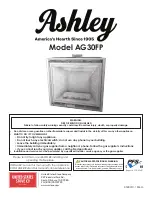
ENGLISH
06.2
RECOMMENDED FUELS
WOOD COMBUSTION
Wood clean burning is a process that reflects the natural decomposition itself; this means that CO
2
(carbon dioxide)
released does not increase or damage the CO
2
original contents in the atmosphere.
The basic prerequisites for clean combustion are:
1.
Using dry and untreated wood
2.
Using the correct size and quantity of combustible: too little firewood or logs too large impede the fireplace to reach
the optimum operating temperature.
KINDS OF WOOD
Each type of wood is characterized by its own density (weight related to the volume) and from different calorific values
(related to the mass and moisture present). We can identify two broad categories: hardwoods and softwoods.
Hardwoods, usually deciduous woods, are the most dense ones, weigh heavily and contain very little resin, burn slowly and
are the best materials in providing long ranges of combustion.
Softwoods, such as conifers, have a lower density, produce a strong warm but burn much more quickly; so they are better
advised for starting combustion; if used as main combustible it would be necessary to load the fireplace more frequently;
furthermore their high resin contents bring to more dirt, flue gases and unburned components.
KIND OF WOOD
HEATING POWER [kWh/kg]
Silver Fir
4,5
Red Fir
4,4
Birch Tree
4,3
Hornbeam
3,9
Beech
4,0
Ash
4,2
Poplar
4,1
Oak
4,2
Locust (Robinia)
4,1
Durmast
4,2
SOME TIPS AND INFORMATION
•
The best fuel is air dried untreated wood, with a humidity of ≤ 15-18%, beech, hornbeam, oak and acacia are highly
recommended.
•
The wood must be stored outdoors in a protected, dry and well-ventilated area.
•
Excessively humid wood generates lower heat output, faster blackening of the glass and rapid corrosion of the heat
generator.
•
The wood must not be too old as it loses its capacity to catch fire (≤ 15 years).
SUITABLE QUALITY AND QUANTITY OF COMBUSTIBLE
The fireplace is designed to burn dry firewood having a water contents less than 15-18%. You can burn combustibles such
as wood briquettes.
It should be paid close attention not to put an excessive amount of combustible because it brings the stove to emit an
excessive amount of heat, so undergoing a warming over the predicted values and then causing really a potential damage
to the structure as well as increased non-standard gas emissions.
IT IS FORBIDDEN TO BURN:
Burning waste of any kind, in particular plastics, is prohibited by law and because it can damage both the stove and the
flue gas chimney.
It is also forbidden to burn given materials such as :
•
Wet wood or bark residues
•
Chipboard panels or (un)coated panel materials
•
Paper, cardboard and old clothes
•
Plastics and foams
•
Wood treated with products for conservative treatments
•
All solid or liquid materials which are not wooden
The efficiency of the fireplace also depends on the chimney draf.
WOOD QUALITY IS VERY IMPORTANT; PLEASE READ THIS SECTION CAREFULLY.
The characteristics of fuel wood for stoves and fireplaces are defined by quality classes A1 and A2 set forth by UNI EN ISO
17225-5 standard.
WARNING
15
Содержание AERJOLLY 80 EVO 12
Страница 42: ...42 NOTES ...
Страница 43: ...ENGLISH NOTES 43 ...
















































